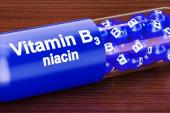Niacin, When Broken Down by the Body, Can Spur Inflammation
Researchers say this may explain why trials of niacin failed to show decreases in CV events.

Niacin, once explored as a therapy for reduction of cardiovascular risk, has fallen out of favor over the past decade as trials failed to support its use. Now, new mechanistic data suggest downstream metabolites that emerge when the body breaks down excess niacin, also known as vitamin B3, could in fact raise the risk of MACE by increasing inflammation.
Speaking with TCTMD, senior author Stanley L. Hazen, MD, PhD (Cleveland Clinic, OH), said the team didn’t initially start out with niacin in mind.
“That wasn’t how this began,” he noted. “It began with a search for new pathways that contribute toward residual cardiovascular disease risk. . . . Are there chemicals in the blood that predict future development [of disease]?”
Niacin was high on the list of suspects, but its connection was unclear, Hazen explained. As it turns out, niacin as a single entity wasn’t the driver of risk, but rather “two co-eluted structural isomers—4PY and 2PY—that are [produced] as breakdown products of niacin,” he continued. “That’s where some ‘aha moments’ happened, because there’s always been this paradox about niacin. We know that it lowers cholesterol levels, but the amount of benefit is really a lot less than what we would predict.”
Given at doses of 1,500 to 2,500 mg per day, niacin was an early agent used to treat dyslipidemia, the researchers point out in their paper, published in Nature Medicine. But in the modern statin era, they say, its efficacy for CVD risk reduction is less certain.
The HPS2-THRIVE and AIM-HIGH trials, in particular, “have shown that, although niacin can reduce LDL cholesterol (and both raise high-density lipoprotein (HDL) cholesterol and lower triglycerides), in the setting of combined high-potency statin therapy, niacin not only failed to diminish CVD risk, but in a meta-analysis of the most recent trials, it even heightened overall mortality,” the paper notes.
Beyond therapeutic niacin, however, there’s the issue of dietary sources. Starting in the early 1900s, some grain products were fortified with niacin to prevent pellagra, a disease resulting from deficiency of the essential micronutrient. Now, with processed foods become ever more commonplace, people are ingesting rising levels of niacin.
For patients, Hazen said, the message is not that the niacin they encounter in natural, whole foods is unsafe. Rather, they should be aware that many products already contain the micronutrient and not intentionally seek out extra amounts through supplements, energy drinks, and other forms.
Hazen noted that although interest in niacin’s CV impact has waned, it still holds appeal in the public for its reputation as an antiaging agent. These products contain niacin or its metabolically active form, nicotinamide adenine dinucleotide, not the breakdown metabolites.
“There is no upper amount of niacin that I can give to say that ‘Above this amount a person is going to make 4PY,’” he said, adding that it would be useful, though, to have a clinically available in vitro diagnostic test to measure 4PY. “People need to have niacin in their diet, and you can’t help but [consume] it, because there’s so much of it in everything that’s in the base of our food pyramid now, because of all the mandated fortifications that are there.”
That said, people should “avoid extraneous supplements” and eat a balanced diet, Hazen advised.
Niacin in Excess
Led by Marc Ferrell, MD (Cleveland Clinic and Case Western Reserve University, Cleveland, OH), the researchers started out by doing an untargeted metabolomics analysis of fasting plasma obtained from stable cardiac patients. In this discovery cohort of 1,162 people (36% female), two metabolites—N1-methyl-2-pyridone-5-carboxamide (2PY) and N1-methyl-4-pyridone-3-carboxamide (4PY)—signaling excess niacin were associated with the risk of incident MACE, defined as MI, stroke, and death.
Then, in validation cohorts from the US (n = 2,331; 33% female) and Europe (n = 832; 30% female), serum levels of the breakdown metabolites were significantly tied to higher 3-year MACE risk, with adjusted hazard ratios ranging from 1.64 to 2.02.
Genetic analyses also drew a link: the variant rs10496731 was significantly associated with 2PY and 4PY levels, and with levels of soluble vascular adhesion molecule 1 (sVCAM-1), which plays a known role in vascular inflammation and atherogenesis. Interestingly, “there’s a connection between tryptophan metabolism and niacin,” said Hazen. “As you eat protein, a portion of the protein—the tryptophan—does feed into the niacin pool.” The extent to which this happens depends on genetics, he added.
Their genetic studies, he added, are what led them to recognize the connection among the breakdown metabolites, inflammation, and CVD risk. In mouse models, the researchers found that giving 4PY, but not 2PY, induced expression of VCAM-1 as well as leukocyte adherence to vascular endothelium.
“Collectively, these results indicate that the terminal breakdown products of excess niacin, 2PY and 4PY, are both associated with residual CVD risk,” Ferrell and colleagues conclude. “They also suggest an inflammation-dependent mechanism underlying the clinical association between 4PY and MACE.”
Hazen noted to TCTMD that the body only makes 4PY in the context of excess niacin. Their findings, he added, “provide a foundation for potential new interventions and therapeutics to reduce or prevent vascular inflammation—a precursor and participant in atherosclerotic cardiovascular disease.”
Allen Taylor, MD (MedStar Washington Hospital Center, Washington, DC), who has studied niacin in the past, commented on the new findings for TCTMD.
With niacin, just “as for many small-molecule drugs with metabolites and diverse mechanisms of action, there can be a mixture of intended and unintended effects,” he wrote via email. What’s of interest is the “net” effect, something that “can be best discerned through properly designed and conducted clinical trials.”
Taylor said that the recent clinical trials of niacin “were in many ways significantly flawed.” But the question of niacin’s role has continued to evolve given that in the years since those data were released, “newer, more-potent, and well-evidenced clinical therapeutics have become available and supplanted many previously used lipid-management approaches in our clinical armamentarium,” he observed.
Caitlin E. Cox is News Editor of TCTMD and Associate Director, Editorial Content at the Cardiovascular Research Foundation. She produces the…
Read Full BioSources
Ferrell M, Wang Z, Anderson JT, et al. A terminal metabolite of niacin promotes vascular inflammation and contributes to cardiovascular disease risk. Nat Med. 2024;30:424-434.
Disclosures
- This work was supported by grants from the National Institutes of Health, Pilot Project Programs of the USC Center for Genetic Epidemiology and Southern California Environmental Health Sciences Center, and the Deutsche Forschungsgemeinschaft.
- Ferrell reports no relevant conflicts of interest.
- Hazen reports being named as a co-inventor on pending and issued patents held by the Cleveland Clinic relating to cardiovascular diagnostics and therapeutics; having received royalty payments for inventions or discoveries related to cardiovascular diagnostics or therapeutics from Cleveland Heart Lab, a fully owned subsidiary of Quest Diagnostics, and Procter & Gamble; being a paid consultant for Zehna Therapeutics and Proctor & Gamble; and having received research funds from Zehna Therapeutics, Proctor & Gamble, Pfizer, and Roche Diagnostics.
- Taylor reports serving on the speakers’ bureau of Amgen.



Comments